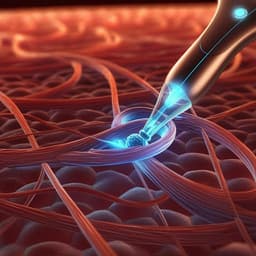
Medicine and Health
Wearable battery-free theranostic dental patch for wireless intraoral sensing and drug delivery
Z. Shi, Y. Lu, et al.
Explore groundbreaking advancements in dental care with a miniaturized, battery-free wearable dental patch developed by Zhenghan Shi and colleagues. This innovative system detects acidic environments and delivers fluoride seamlessly, providing timely prevention against dental caries and revolutionizing oral disease management.
~3 min • Beginner • English
Introduction
The study addresses the global burden of dental caries, a prevalent non-communicable disease driven by oral microbiome dysbiosis and acidogenic/aciduric bacterial activity. Early lesions are often asymptomatic and undetectable by conventional visual inspection and radiography; however, they can be arrested or reversed with timely topical fluoride exposure. Real-time, in situ monitoring of the topical microenvironment (notably pH) on tooth enamel is needed to reveal demineralization dynamics and guide intervention. Bulky intraoral systems based on rigid batteries hinder comfort and localized sensing, while near-field communication (NFC) offers battery-free energy harvesting and data transmission suitable for miniaturized flexible devices. The authors propose a conformal, battery-free, wireless dental patch capable of potentiometric pH sensing to detect acidification from bacterial metabolism and an electrically controlled fluoride delivery module for on-demand therapy, both powered and commanded via NFC-enabled smartphones.
Literature Review
The authors review that caries activity tests requiring in vitro culturing are time-consuming and lack real-time insights. Wearable flexible electronics with electrochemical sensors have been applied to biofluid monitoring, and prior intraoral devices have mounted sensors on mouthguards; yet rigid lithium-ion batteries and radio modules limited miniaturization, flexibility, and localization to specific tooth sites. NFC has emerged for simultaneous energy and data transfer through inductive coupling, enabling battery-free designs. Conducting polymers (e.g., polyaniline, polypyrrole) support low-power sensing and electrically controlled drug release, aligning with NFC-powered platforms. Traditional fluoride delivery (toothpaste/mouthwash) suffers from low retention and risk of overuse, motivating controlled, topical delivery solutions within the oral environment.
Methodology
System design: A miniaturized (10 mm × 8 mm), battery-free, flexible dental patch comprised two layers: (1) a polyimide-based flexible control circuit with NFC chip, microcontroller (MCU with integrated 12-bit ADC/DAC and op-amps), passives, and an NFC antenna; and (2) a flexible electrode array on PDMS for sensing and drug delivery. The device wirelessly harvests energy and exchanges data with NFC-enabled smartphones at 13.56 MHz. The MCU performs open-circuit potentiometry for pH sensing and applies constant potentials for drug release.
Electrode array fabrication: A multilayer ultrathin array (≈15 mg) used screen-printed carbon (working) and Ag/AgCl (reference) electrodes, serpentine copper interconnects encapsulated with PI, and PDMS support for conformal tooth attachment. Mechanical flexibility under bending and stretching was verified.
Sensor modification: Gold nanoparticles were electrodeposited onto carbon to enhance conductivity, followed by in situ electrochemical polymerization of polyaniline (PANi) as the H+ sensing layer (coral-like morphology by SEM). The reference electrode was coated with a PVB mixture (with NaCl, CNTs) to stabilize potential and reduce drift.
Drug delivery electrode modification: Polypyrrole doped with fluoride (PPy/F) was formed by chronopotentiometric polymerization in pyrrole/NaF solution to load fluorides. To suppress spontaneous release, an overlayer of PPy doped with polystyrene sulfonate (PPy/PSS) was added, forming a bilayer. SEM revealed cauliflower morphology; EDS confirmed C, N, and F in PPy/F.
In vitro sensor characterization: Open circuit potential measurements across McIlvaine buffers (pH 3–8) assessed sensitivity, linearity, and response. Selectivity was tested against K+, Ca2+, Na+, and Mg2+ at physiological levels. Validation used S. mutans dental plaque formation on enamel slices with continuous pH monitoring over 10 h, corroborated by a standard pH meter and SEM of plaque stages.
In situ intraoral monitoring: Calibrated patches were attached to consenting volunteers’ teeth using a transparent dental strip. Real-time pH responses to beverages (acidic cola, alkaline soda water, pure water) were recorded. Daylong monitoring captured pH every 2 h (3 min per measurement). Caries activity was independently assessed via a commercial colorimetric kit (Cariostat) after 48 h culture of sampled oral bacteria.
Drug delivery evaluation: Fluoride content was quantified via spectrophotometric assay (calibration 5–100 µM). Effects of PPy/F synthesis time (5–20 min), spontaneous release (mono- vs. bilayer), and controlled release potentials were evaluated. Periodic electrical stimulation (e.g., −0.9 V) characterized release dynamics and power consumption. Antibacterial effects were examined by culturing S. mutans with electrically released fluorides and imaging with CLSM using LIVE/DEAD staining.
Electronics: NFC chip NT3H2111 and MCU MSP430FR2355 implemented power management, sensing, and stimulation. A custom mobile application provided data display and therapy commands.
Key Findings
- Device form factor and integration: The battery-free dental patch measured 10 mm × 8 mm × 1.5 mm and weighed 90 mg; the electrode array weighed ~15 mg. NFC provided wireless power and data, eliminating rigid onboard batteries and improving intraoral comfort and safety.
- Sensor performance: The PANi-based potentiometric pH sensor exhibited stepwise, stable responses from pH 8 to 3 with near-Nernstian sensitivity of 62.97 mV per decade of H+ concentration and excellent linearity (R^2 = 0.9990) after one-point calibration at pH 7. Selectivity tests showed negligible interference from K+, Ca2+, Na+, and Mg2+ at physiological concentrations.
- Biological validation in vitro: During S. mutans plaque formation, environmental pH decreased from 6.9 to 4.5 over 10 h, consistent with a standard pH meter. SEM corroborated plaque development from colonization to mature biofilm (porous matrix) as acidity increased.
- In situ intraoral monitoring: Beverage challenge showed topical pH rose from ~5.0 to ~6.0 after alkaline soda water (pH 8.0) and fell below 3.0 after acidic cola (pH 2.5), returning to baseline after drinking water (pH 6.8). Daylong monitoring in two subjects (every 2 h) revealed meal-associated pH drops after carbohydrate-rich meals: to ~3.7 and 4.0 post-lunch, with further decreases after dinner; subject B declined from 4.5 to 3.3 and showed sustained acidification. Caries activity test indicated higher acidogenic potential for subject B, aligning with sensor data.
- Drug loading and release control: Fluoride loading increased with PPy/F synthesis time; 20 min polymerization balanced performance and safety. Spontaneous release over 3 h was reduced by a PPy/PSS overlayer (monolayer PPy/F: 27.9 nmol; bilayer PPy/PSS+PPy/F: 18.4 nmol). Electrically controlled release was tunable by applied potential; periodic stimulation at −0.9 V produced higher release rates than spontaneous diffusion. Typical delivery current was ~20 µA with power consumption <30 µW, compatible with NFC powering.
- Antibacterial effect: CLSM showed reduced bacterial density and increased membrane-compromised (red-stained) S. mutans in fluoride-treated conditions, indicating inhibition of cariogenic bacteria and potential to maintain/restore microenvironmental pH.
Overall, the system enabled real-time, localized detection of acidic shifts indicative of caries risk and on-demand, low-power, wirelessly controlled fluoride delivery with demonstrated antibacterial activity.
Discussion
The results demonstrate that conformal, battery-free intraoral electronics can monitor tooth-surface microenvironmental acidity in real time and trigger targeted therapy. High sensitivity and selectivity of the PANi sensor capture dynamic acidification from bacterial metabolism that precedes clinically visible lesions, enabling early alerts. The NFC-powered PPy-based module delivers fluorides on demand with low power and adjustable dosing, reducing spontaneous leakage via a bilayer design and achieving antibacterial effects against S. mutans. These capabilities directly address the need for point-of-care caries prevention by coupling diagnosis and therapy at the lesion site. Beyond caries, the platform can be adapted to other oral niches and biomarkers by reprogramming electrochemical modes and loading alternative therapeutics, supporting broader oral health monitoring and personalized interventions.
Conclusion
A fully integrated, wearable, battery-free dental patch was developed for intraoral theranostics, combining potentiometric pH sensing with electrically controlled fluoride delivery, both wirelessly powered and controlled via NFC smartphones. In vitro and human studies confirmed reliable real-time monitoring of topical acidity and effective, low-power, on-demand fluoride release with antibacterial activity. This platform advances point-of-care oral health management by enabling early detection and timely treatment of caries risk and is extensible to other oral biomarkers and drugs for personalized care.
Limitations
- Hardware reusability and cost: Current solid-welded connections between circuit and electrode could be replaced by detachable magnetic or plug-in conductive connectors to enable circuit reuse and reduce costs.
- Wearability and safety: Soft encapsulation materials require further optimization (biocompatibility, rigidity, permeability, reversible adhesion) to maximize comfort and safety for long-term intraoral use.
- Communication range: NFC inherently limits operating distance due to smartphone-integrated coils; custom mobile terminals with larger reading coils could improve practicality and usability.
Related Publications
Explore these studies to deepen your understanding of the subject.







